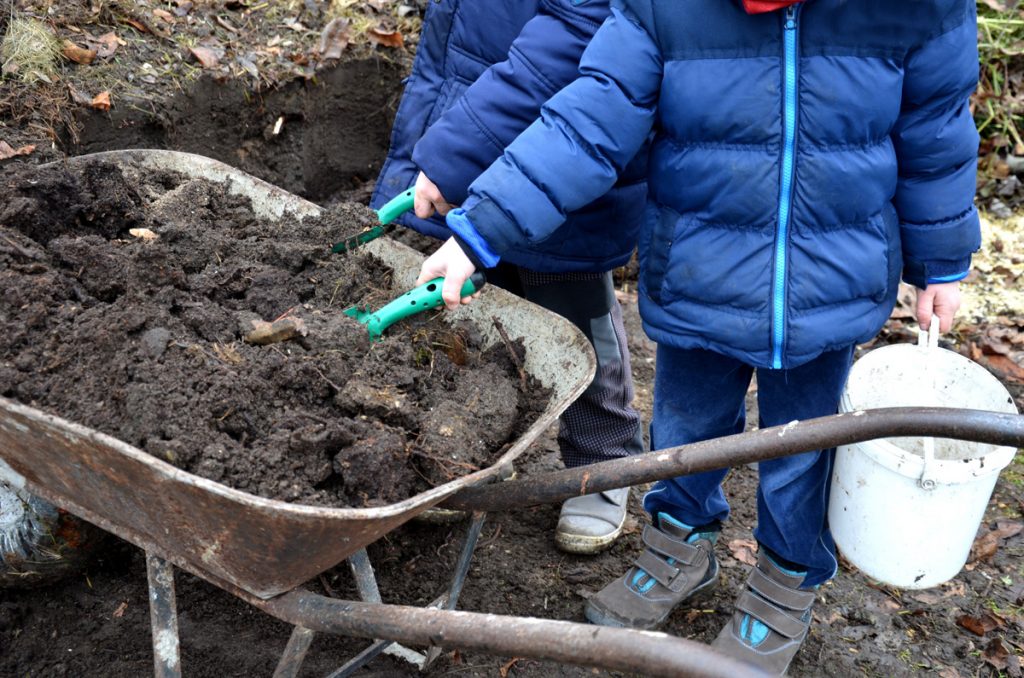By Alan Chan
Composting is great fun, as well as an engaging and educational task for children. Not only is it a lesson in environmental awareness but you’re building sustainable habits from a very early stage.
The next time you’re at the dinner table, have a discussion with your children about why composting is helpful for the environment and the amazing benefits and rewards that can be reaped from upcycling food scraps. The size, sight (and contents!) of the compost bin might be a bit daunting and unappealing at first, but there are some things you can do to help them on this journey.
Personalised Compost Bucket
Get the kids a small plastic bucket and give them the responsibility to fill it with kitchen scraps for carrying to the compost. Having ownership of the bin makes it more personable and fun; you can also encourage your child to decorate the compost bucket with some stickers or markers. The idea of the compost bucket is to keep this in the kitchen as you prep food for family meals, and once it’s full it can be taken out to be emptied into the compost bin.
Turn composing into a game
The compost bin should include a mixture of brown ‘crunchy’ materials such as dried leaves, sticks, newspaper and cardboard. It should also be a mixture of household green waste such as fruit, vegetable scraps, and grass clippings. Use a trip to the park as an opportunity to find leaves and sticks – count them, compare shapes and colours, and take a pick-up stick to make collecting fun. Count each one together as you place into the compost bin and use the opportunity to talk about how leaves and scraps will become soil to nourish new plants and trees. If you have a bokashi bin or above-ground compost, you can set up a mini garden or herb garden for the kids, and use the compost as fertiliser.
Worm Farm composting
Make your own worm farm compost bin out of a plastic bin by drilling holes on the top, base and sides of the bin. Kids are fascinated by worms and this is a great idea to introduce them to composting in a really hands-on way. Get your child a magnifying glass so they can spot the worms in the bin – they will love this! It’s easy to buy live worms to kick start this project; the bags normally come in 500 or 1000 worms. You will need 500 worms to get yourself started as well as bedding such as newspaper torn into strips. Keep the bedding evenly moist by misting it with water using a spray bottle. Kids will love feeding the worms with fruit and vegetable scraps. Place these scraps in your child’s compost bucket or use a favourite bowl and let the kids place the scraps into the worm farm, spreading the food waste evenly.
Read children’s books about composting
A great way to engage children about composting from an early age is to expose them to fantastic literature on the topic. Reading books to children is not only fun but very engaging and helps kids understand the concepts of waste, recycling, and upcycling. Some of my favourite books about composting are:
- Compost Stew by Mary McKenna Siddals
- Composting: Nature’s Recyclers by Robin Koontz
- Save The Scraps by Bethany Stahl
- The Little Composter by Jan Gerardi
- Green Machine: The Slightly Gross Truth about Turning Your Food Scraps into Green Energy by Rebecca Donnelly
- What’s Sprouting in My Trash? A book about composting by Esther Porter
- Compost: A family guide to making soil from scraps by Ben Raskin
Plant flowers and vegetable seedlings
Once you’ve established your compost bin and your compost is ready to use in the garden, encourage your kids to plant their favourite flowers using the homemade compost. Popular and easy to grow flowers include pansies, marigolds, sunflowers and daisies. Something really bright and colourful can help inspire and encourage children to do more composting as they can see the benefits of this in the garden and watch their flowers grow and flourish. Alternatively, children can plant vegetable seedlings such a tomatoes, lettuce, chives and dill in the garden bed using the compost. They can do a fun experiment together by comparing seedlings grown in the compost and one without and allow them to spot the difference in growth each week. Get your kids to take photos and do drawings of their plants. The magnifying glass will come handy here again!
Take these helpful hints and allow your children to join the journey of home composting. Take your time, enjoy the journey, and know that it’s important to have regular discussions about waste so you can maintain this excitement for children to keep caring for the planet for many years to come.
Alan Chan of @plant.jungle is a millennial plant-fluencer, obsessed with creating and growing his own indoor jungle. Via Instagram he shares tips, tricks, and lifestyle hacks for gardening in small spaces, propagation, and plant care. Alan, aka the ultimate green thumb, has created a feel-good space online that welcomes and nurtures any like-minded plant lovers.


